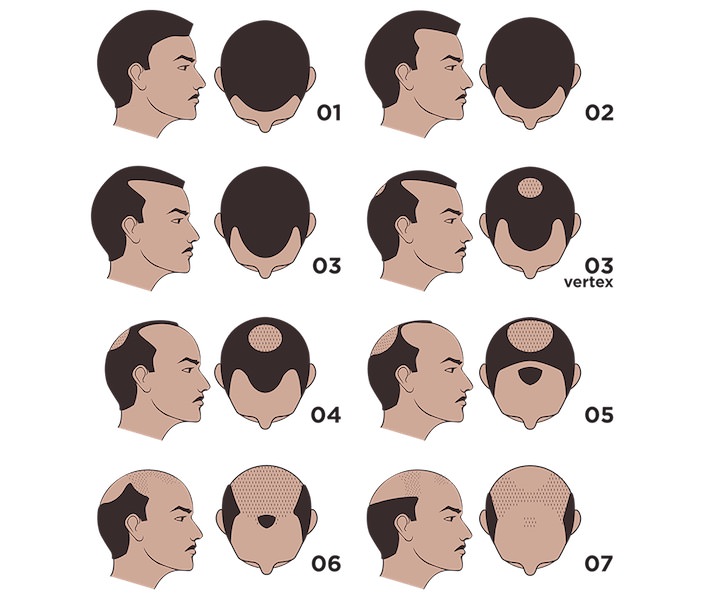The Norwood Scale: Hair Loss Stages

Male pattern baldness is often measured by the Norwood Scale, the most popular classification system for hair loss in men. When men start to lose their hair, they typically start to see a pattern over the course of many years. The Norwood Scale assesses the progression of hair loss on a scale of one to seven. Once the classification stage is identified, a practitioner will be better able to choose an appropriate treatment option and measure its effectiveness. You can choose between options like medications, transplants, or a hair tattoo. The Norwood Scale helps determine when to begin treatment and what results to expect.
Norwood Scale: Seven Stages of Hair Loss

Stage 1: There are no signs of a receding hairline or bald spots in stage one. It is often called the control stage, identified by a full head of hair.
Stage 2: A slight recession in the hairline can start to be seen around the temples. The initial signs of hair loss become apparent in this stage.
Stage 3: The first signs of significant hair loss or clinical balding are seen in this stage. The hairline recedes further into a U, M, or V shape. In this stage, the crown also starts to thin. In some cases, the crown may already have given way to a bald spot on the scalp (vertex).
Stage 4: Hair loss continues to progress more severely, with little to no hair on the vertex. A strip of hair now separates the two areas of hair loss and connects to the hair on the sides of the head.
Stage 5: The receding hairline and the bald spot on the crown grow significantly larger. Compared to the strip of hair in stage four, the hair between the two balding areas is much thinner.
Stage 6: The balding areas on the forefront and crown join together with no strip of hair connecting them. In this stage, a person is mostly bald, although there may be hair still on the sides of the head.
Stage 7: Hair loss is the most severe at stage seven. Only a thin band of hair encircles the sides of the head. Whatever hair is left may be sparse or very fine.
Diagnosis and Solutions for Hair Loss
Hair loss is usually diagnosed by a hair loss specialist or a dermatologist. The hair will be examined closely to determine the extent of hair loss. A provider will try to rule out other possible causes of hair loss, such as medications, diet, and hair care products. Once male pattern baldness is diagnosed, a provider will go through your available treatment options. Hair loss can be treated in the following ways:
Hair Loss Medications
Medications like minoxidil, also known as Rogaine, can be applied directly to the scalp. Finasteride is an oral medication that is FDA-approved to treat male pattern hair loss. Also known as Propecia, finasteride prevents the conversion of testosterone to dihydrotestosterone (DHT), a hormone responsible for hair loss in men. Rogaine and Propecia often are accompanied by side effects that can become negative in a man’s day-to-day life.
Hair Transplantation
Hair transplantation uses hair cells from a different area of the head to regrow hair. Once a specialist gathers the hair follicles, they transplant them to balding areas like the hairline or crown. Hair transplantation can be an effective solution for male pattern baldness if you are a good candidate. Hair transplantation is a surgery and will often leave scarring on your scalp’s donor area. Check out the difference between hair transplants and scalp micropigmentation in the video below:
Scalp Micropigmentation
Scalp micropigmentation (SMP) is a less invasive treatment option for hair loss. It involves inserting pigment into the scalp to recreate the appearance of hair. Scalp micropigmentation covers a receding hairline and any bald spots to create the look of a short, buzzed hairstyle. Individuals get to experience immediate, natural-looking results after their first appointment. Follow-up appointments may be required to intensify the look of your pigment.
A hair tattoo can also be used to cover scars that may have been left after a hair transplantation procedure. Because hair loss is mostly genetic, it is not often easy to prevent entirely. With the Norwood Scale, hair loss specialists can better identify stages of hair loss to recommend the best treatment option. When getting scalp micropigmentation, the Norwood scale plays a role in the estimated cost for your treatment. Talk to our hair tattoo specialists to determine if this hair loss solution is right for your needs and goals.
A scalp tattoo provides a quick, low-maintenance solution for hair loss or scarring on the scalp. Unlike medications that you have to use consistently or costly hair transplants, Scalp Micro USA offers an easy, accessible solution for our customers. With proper care, your hair tattoo can last for years, and your SMP artist will tailor your scalp tattoo depending on the shape and color you want. Contact our team today with any questions or to get a complimentary consultation.

Tired of hair loss?
Get the perfect hairline, 100% guaranteed, with our scalp
micropigmentation treatment that is customized just for you. No more
crazy combovers. No more ineffective medications. Just results.